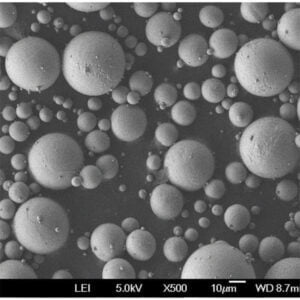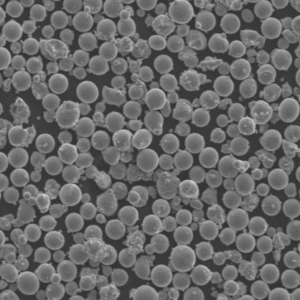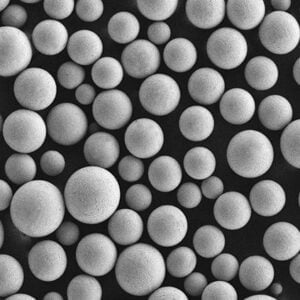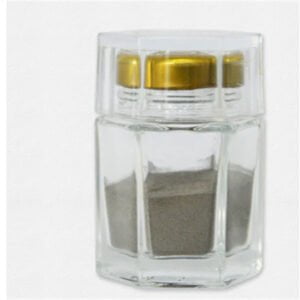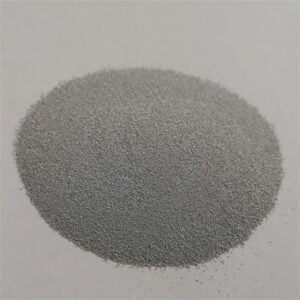ニッケル系パウダー
目次
ニッケルベースの粉末 ニッケル粉末とは、積層造形、表面コーティング、溶接など、様々な用途に使用されるニッケルまたはニッケル合金から作られた粉末を指します。この記事では、ニッケルベースの粉末の概要、組成と特性、用途、仕様、価格、比較、よくある質問について説明します。
概要 の ニッケル系粉末
ニッケル系粉末は、ニッケルを主成分とし、クロム、モリブデン、タングステンなどの合金元素からなる金属粉末です。これらの粉末を高性能用途に適している主な特性は以下の通りです:
- 高温での高い強度と硬度
- 優れた耐食性と耐酸化性
- 優れた耐摩耗性
- 高い熱伝導性と電気伝導性
- 低熱膨張係数
これらの粉末は、ガスや水の噴霧化、電気分解、カルボニル分解などのプロセスを通じて、様々なサイズや形態で製造することができる。一般的に使用されるニッケル合金は、インコネル、モネル、ハステロイ、ニクロムなどです。
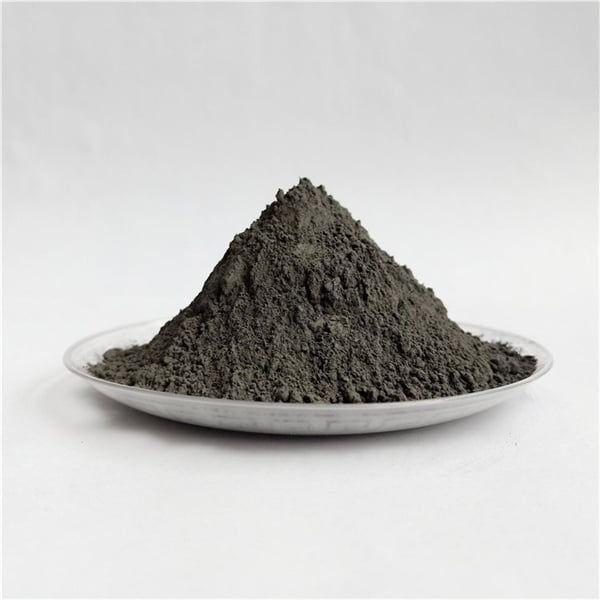
ニッケル系粉末 構成
ニッケルベースの粉末 はニッケルを主成分とし、他の合金元素を含む。代表的な組成は以下の通り:
| 合金 | ニッケル(%) | その他の要素 |
|---|---|---|
| ニッケル | 99%+ | – |
| インコネル | 72% Ni, 14-17% Cr | 鉄、ニオブ、銅、アルミニウム |
| モネル | 63-70% Ni, 27-34% Cu | 鉄、マンガン、ケイ素、炭素 |
| ニクロム | 80% Ni, 20% Cr | 鉄 |
| ハステロイ | 42-62% Ni | クロム、モリブデン、タングステン |
ニッケルと合金の比率は、強度、耐食性、耐酸化性などの主要な特性を決定する。
ニッケル系粉末 プロパティ
ニッケル合金粉末は、ニッケルよりも優れた特性を持ち、過酷な環境に適しています:
| プロパティ | 特徴 |
|---|---|
| 高温強度 | 強度を保持し、1000℃以上でのクリープ変形に耐える |
| 耐食性 | 保護酸化膜を形成し、酸、アルカリなどに耐性を持つ。 |
| 耐酸化性 | 1100℃までの空気中では酸化速度が遅い。 |
| 耐摩耗性 | 耐浸食性、耐摩耗性、耐カジリ性がスチールより優れている。 |
| 熱伝導率 | ステンレス鋼より高く、インコネル625では~20 W/m.K |
| 電気抵抗率 | 発熱体の抵抗率が高い合金の範囲 |
| 熱膨張係数 | 低熱膨張率による耐熱衝撃性 |
種類 ニッケル系粉末の
ニッケル粉末には、さまざまな蒸着法に適した種類がある:
| タイプ | 一般合金 | サイズ範囲 | ** 形態学 |
|---|---|---|---|
| ガスアトマイズド | インコネル625、718; モネル、ハステロイ | 5 - 150 μm | 丸みを帯びた球形 |
| 水アトマイズド | インコネル625、718、316L、304L | 10 - 300 μm | ギザギザ、不規則 |
| 電解 | ニッケル、モネル、ニクロム | 1~150μm | 樹状、結晶性 |
| カルボニル | ニッケル | 0.5 - 12 μm | フレーク、チップス |
- ガスと水の霧化により、充填密度と流動性が向上
- 電解は酸素含有量が高く、空隙を生じさせる。
- カルボニルニッケル粉末は高純度(>99% Ni)
ニッケル系粉末 アプリケーション
ニッケル合金粉末の主な用途は以下の通り:
| 産業 | アプリケーション |
|---|---|
| アディティブ・マニュファクチャリング | 航空宇宙部品、タービンブレード、ロケットエンジン |
| 溶接 | タービン、工具、金型の修理、インコネル、ハステロイの接合 |
| 表面コーティング | 腐食保護、耐摩耗性、オーバーレイコーティング |
| エレクトロニクス | 抵抗器、発熱体、導体 |
| ダイヤモンド工具 | 切断、穴あけ、研削用ボンディング・ダイヤモンド砥粒 |
| マグネット | 磁気特性の改善 |
| バッテリー | Ni-Cd、Ni-MH電池のニッケル電極 |
高強度や耐食性といった独自の特性により、ニッケル粉末は重要な用途を可能にする。
ニッケル系粉末 仕様
ニッケル合金粉末は様々なサイズ、形態があり、信頼できる性能を発揮するためには、組成、純度、一貫性の仕様を満たす必要があります。
| パラメータ | レンジ/グレード |
|---|---|
| 粒子径 | 5 μm~300 μm |
| 粒子形状 | 球状、不規則、フレーク |
| 見かけ密度 | 2 - 5 g/cc |
| タップ密度 | 4 - 7 g/cc |
| 流量 | 15~25秒/50g |
| 純度 | 98.5%~99.9% |
| 酸素含有量 | <0.5% |
| 水素ロス | <0.1% |
ASTM Internationalのような標準化団体は、ニッケル粉の試験方法と閾値に関する仕様を提供しています:
- ASTM B162:ニッケル板、板、帯、圧延棒の規格
- ASTM B283:ガスアトマイズニッケル粉末および粉末冶金製品
- ISO 4499-4:金属粉 - 熱間抽出による酸素及び窒素含有量の測定
ニッケル系粉末 サプライヤーと価格
ニッケルおよびニッケル合金粉末の世界的な主要サプライヤーには、以下のようなものがある:
| 会社概要 | ブランド | 合金 | 価格帯 |
|---|---|---|---|
| ホーガナス | ニコパウダー | ニッケル、カルボニルニッケル | $50〜$100/kg |
| サンドビック・オスプレイ | ニフコ | ニッケル、銅ニッケル、ニッケル鉄 | 1kgあたり$75~$250 |
| カーペンター・テクノロジー | カーテック | 625、718、690、モネル、ハステロイ | $100〜$500/kg |
| アメテック | 超微粒子ニッケル | カルボニルニッケル | 1kgあたり$80~$120 |
料金設定は以下の通り:
- 合金グレード:インコネル718 > インコネル625 > ニッケル > モネル
- 粒子径ナノパウダー > マイクロパウダー
- 純度レベル:99.9%ニッケル > 98%ニッケル
- 数量およびバルク割引
比較
| パラメータ | ガスアトマイズド | 水アトマイズド | 電解 |
|---|---|---|---|
| コスト | 高い | 低い | ミディアム |
| 純度 | 高 - 99%+ | ミディアム - 98-99% | ロー - 90-98% |
| 酸素ピックアップ | 低い | 高い | 高い |
| 粒子形状 | 丸みを帯びた | ギザギザ | 樹状突起 |
| 流動性 | 素晴らしい | 中程度 | 貧しい |
| 見かけ密度 | 高い | ミディアム | 低い |
| アプリケーション | AM、コーティング | 溶接、表面コーティング | 発熱体、電子機器 |
生産工程における主な違いは、コスト、品質、性能のトレードオフにつながる。
メリット の ニッケル系粉末
ニッケル合金粉末は、他の材料と比較してユニークな利点を提供します:
- 1000℃を超える高温に耐える
- 酸性またはアルカリ性環境での耐腐食性
- 複雑な形状の積層造形が可能
- ダイヤモンド工具に優れた接着強度を提供
- 医療用インプラントに生体適合性がある
- 制御された膨張特性を持つ
- 粉末冶金でリサイクルして再利用できる
制限事項
これらのパウダーに関連する欠点はいくつかある:
- 鉄粉や銅粉に比べて高価
- 取り扱い中の酸素汚染に敏感
- 過熱すると表面に亀裂が生じやすい。
- 冷間成形や焼結による加工が難しい
- 溶射中に制御された雰囲気が必要
- 銅に比べて低い電気伝導率と熱伝導率
制限を最小限にするために、適切な粉末の取り扱い、保管、処理方法を用いなければならない。
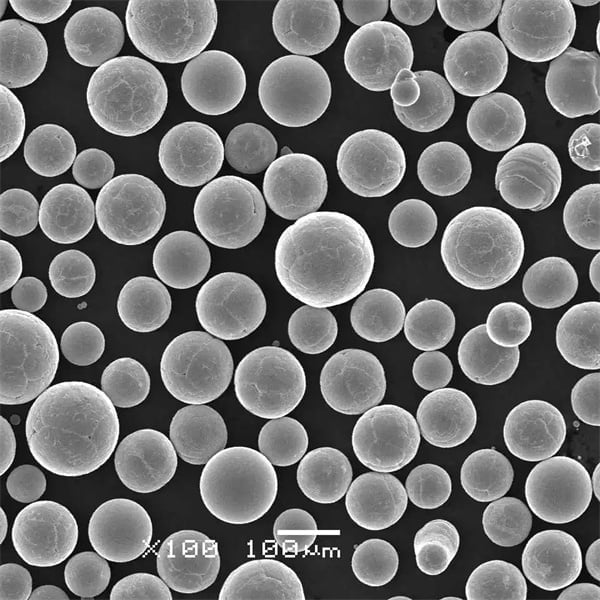
よくあるご質問
Q: ニッケルパウダーは危険ですか?
A: 長期間の吸入により呼吸器感作を引き起こす可能性がある。取り扱い時にはマスクや手袋などの適切なPPEを着用すること。
Q: ニッケルパウダーの保存可能期間はどのくらいですか?
A: 密封容器に入れ、不活性雰囲気下で保存すれば、賞味期限は5年を超えます。酸素や水分の吸収は、時間の経過とともに品質を劣化させます。
Q: 溶射に最適な粒子径は?
A: 20-45μmの方が密度と接着強度が高い。より微細な粉末は蒸着効率が低下します。
Q: これは磁気を帯びているのですか、それとも非磁気ですか?
A: 純ニッケルはわずかに磁性があります。鉄とニッケルを含むニクロムとミューメタルを除けば、ほとんどのニッケル合金は非磁性です。
Q: ニッケル合金は3Dプリントできますか?
A: はい、インコネルとハステロイのグレードは優れた特性を提供しますが、レーザー溶融/焼結に最適化されたパラメータが必要です。
シェアする
MET3DP Technology Co., LTDは、中国青島に本社を置く積層造形ソリューションのリーディングプロバイダーです。弊社は3Dプリンティング装置と工業用途の高性能金属粉末を専門としています。
関連記事
Met3DPについて
最新情報
製品

3Dプリンティングと積層造形用金属粉末






